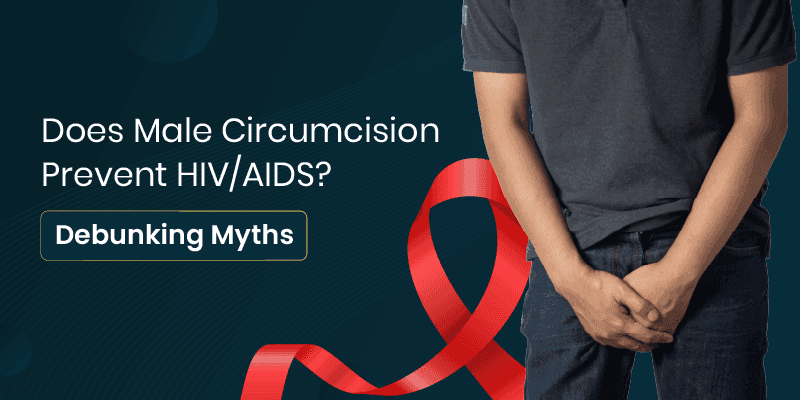Does Male Circumcision Prevent HIV/AIDS? Debunking Myths
In This Article
Does Male Circumcision Prevent HIV/AIDS? Debunking Myths
Jaseela
Updated on March 23, 2024
Medically verified by Dr. Arya
Fact checked by Dr. Pournami

Urology
5 min read
You’re not alone. There are many who want to know if there’s any link between circumcision and prevention of HIV/AIDS and other STIs.
We are here to answer your queries, clear up any misunderstandings, help you see the facts, and debunk certain myths.
Let's get the facts straight and talk openly about this important aspect of public health.
What Is Penile Circumcision?
Before we jump into the circumcision-HIV connection, let’s understand what penile circumcision is.
Penile circumcision is the surgical removal of the foreskin, which is the part of the penis that covers the tip.
This procedure is relatively quick and easy for adults. It is an outpatient procedure with about 10 days of home recovery.
Here are some of the things you can expect before, during and after circumcision:
1. Preparing for the procedure
The first step in preparing for circumcision is to pre-treat and clean the genital area.
After cleaning the area, the doctor will apply general anaesthetic to the nerves surrounding the penis to numb it completely.
Some people have general anaesthesia, meaning they are unconscious and do not feel any pain during the procedure.
2. During the procedure
There are three main surgical methods for circumcision:
The dorsal slit method
The shield and clamp method
The excision method
While the procedure depends on the age and health of the patient, each method allows the doctor to remove the foreskin safely.
3. Recovery
According to the NHS, it can take around 10 days for a penile circumcision to fully heal, or longer if complications occur.
For adults who have had the procedure, doctors advise avoiding other activities for a minimum of 4 weeks, including strenuous physical activity and sexual intercourse.
As with any surgical procedure, there are many variables that can affect the outcome of a circumcision.
However, it is generally accepted that penile circumcision is a safe procedure that can offer many long-term advantages, including preventing sexually transmitted infections (STIs).
Does Penile Circumcision Reduce the Risk of HIV?
According to the CDC, adult male circumcision reduces the risk of HIV infection by as much as 60 percent among men who engage in penile-vaginal sex (MSM).
This reduction was demonstrated in three randomised clinical trials in Africa.
In 2012, the AAP ( American Academy of Pediatrics) issued a policy statement highlighting the positive effects of male circumcision on reducing the risk of HIV, as well as other sexually transmitted infections (STI).
The AAP did not recommend universal male circumcision, but said that the procedure will be made available for all parents who wish to choose it.
The CDC issued official recommendations in 2014 for medical professionals to inform patients about the positive effects of circumcision in reducing the risk of STIs.
A 2017 research review revealed that the CDC continues to support the use of male circumcision as a public health measure and that the practice is still considered important in some countries.
Can Circumcision Prevent Illnesses?
In another 2013 research review, researchers found that penile circumcision may be protective against STIs such as HSV, HPV, and G.U.D. (genital ulcer disease).
However, the authors noted that the results were unclear regarding MSM (male circumcision).
 6 min read
6 min readWhat is Stapler Circumcision - Everything You Need to Know
 8 min read
8 min readIs Circumcision Good or Bad - Here's How to Find Out
 8 min read
8 min readCircumcision - Scientific Guide to All Your Questions
Get a Callback Now
Is Circumcision Effective in Preventing the Spread of STIs to Female Partners?
Penile circumcision may reduce the risk of sexually transmitted infections (STIs) in female sexual partners, but the evidence is mixed.
A 2019 research review carried out by researchers found that male circumcision could protect against the following STIs:
Human Papillomaviruses (HPV)
HPV is a virus made up of more than 100 different strains including several strains that cause cervical cancer.
Studies have shown that circumcised male partners may be less likely to develop the type of HPV that causes cancer in female partners who have penis and vagina sex.
Bacterial Vaginosis
Bacteria is an infection caused by the imbalance of bacteria in the vagina. Millions of people suffer from bacterial vaginosis each year.
Studies have shown that circumcision can significantly reduce the risk of bacterial vaginosis in female partners.
Risks of Penile Circumcision
While circumcision is generally considered to be safe, it does come with some risks. Although complications are rare, some potential complications that could occur are as follows:
- Bleeding
- Influenza
- Concealed penis
- Redundant foreskin
- Excess skin removal
- Skin bridges
- Uterine narrowing
- Loss of Sensitivity
- Risks associated with anaesthesia
The research on penile circumcision is mixed. In 2020, researchers found a consensus of "higher quality" studies that indicated penile circumcision had minimal or no adverse effect.
However, further research is needed. If you are unsure about the risks associated with penile circumcision, consult your doctor or surgeon.
Circumcision is a common medical procedure that may provide protective health benefits to men who have penis- vagina sex. It may reduce the risk of HIV infection in men who have male circumcision.
It may also reduce the risk of multiple sexually transmitted infections (STIs) in female partners, such as Human Papillomavirus (HPV), BV, Trichomoniasis, etc.
When sexually active, using a condom or other barrier method is one of the most effective ways to prevent STIs.
However, circumcision may not provide as much protection for MSM, but it is an effective method for MSM to prevent HIV and STI infections.
As with any medical procedure, there are risks and benefits associated with it. Therefore, it is important to consult with your doctor before you make a decision to opt for it.
Penile circumcision is the surgical removal of the foreskin, which is the part of the penis that covers the tip. According to the Centers for Disease Control and Prevention (CDC), more than 58 percent of male newborns in the United States were circumcised
Risks of penile circumcision include bleeding, influenza, concealed penis, redundant foreskin, excess skin removal, skin bridges, uterine narrowing, loss of Sensitivity and risks associated with anaesthesia.
Researchers found that penile circumcision may be protective against STIs such as HSV, HPV, and G.U.D. (genital ulcer disease). However, the authors noted that the results were unclear regarding MSM (male circumcision).



